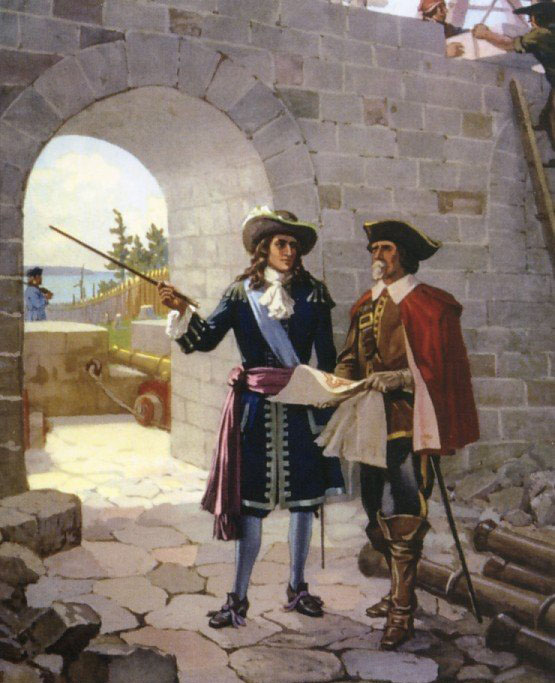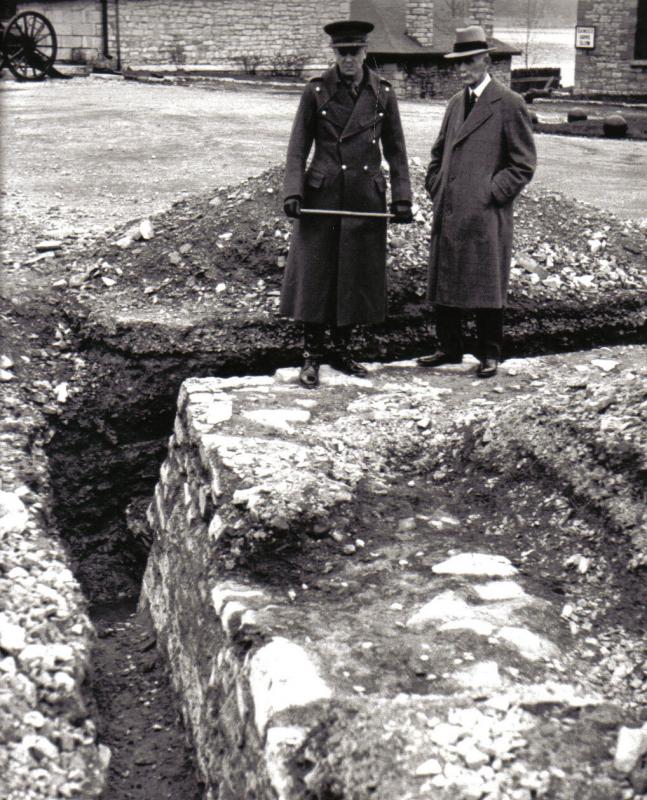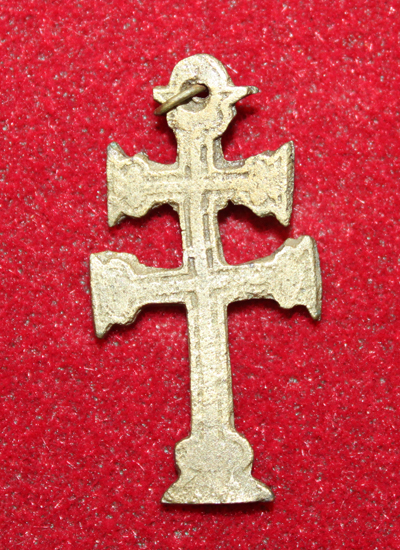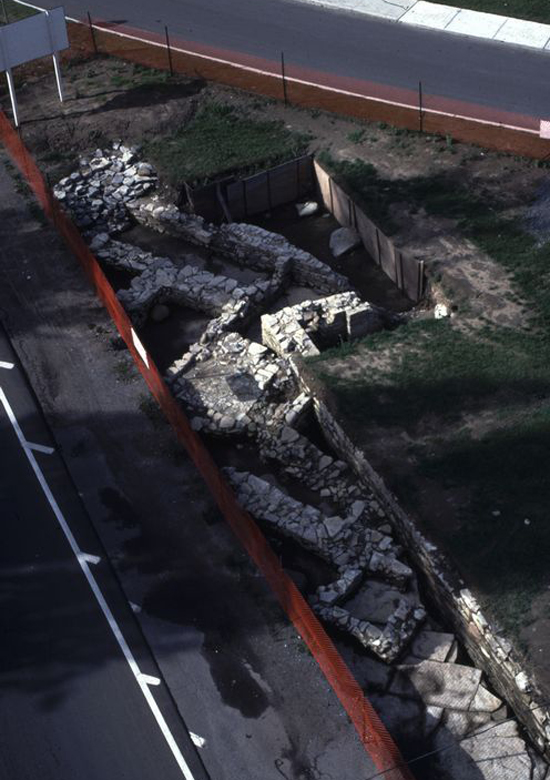On July 12, 1673, the Governor of New France, the Comte de Frontenac, arrived at the mouth of the Cataraqui River to meet with leaders of the Five Nations of the Iroquois to encourage them to trade with the French. While the groups met and exchanged gifts, Frontenac's men hastily constructed a rough wooden palisade on a point of land by a shallow, sheltered bay. On that day, Fort Frontenac was founded. Its history would span three centuries.
Frontenac's aim was to control access to the fur-rich Great Lakes basin and the Canadian Shield, thereby controlling the highly profitable fur trade, and profit from it. To the most trusted of these associates, Robert Cavalier Sieur de La Salle, Frontenac granted the fort and surrounding lands in seigneury. La Salle however, longed for more than to remain a simple seigneur of Fort Frontenac and would find his destiny in the lands south of the Great Lakes, and in 1682 didn’t return to the fort.

By 1685 the wooden palisade was becoming a fortress with walls of local limestone, square stone bastions, and complex of buildings within the walls. A habitation was developing to the southwest of the fort along the lakeshore. In all appearances it seemed as though the outpost of New France was off to a good start. However, the fort was on shaky grounds. Its shaky position was further magnified by the outbreak of fighting with the Five Nations, spurred on by the conflict between the French and the British for control of the fur trade. The French government increasingly questioned the expense required to defend a post the usefulness of which was uncertain.
In 1688, the garrison at the fort was attacked by the Iroquois, and confined to the fort by a long siege in which 93 men died of scurvy. The following year, the garrison was instructed to raze the fort and return to Quebec: they set charges in the walls and departed. Count Frontenac would not return to the site until 1695, after the war had ended. He brought with him 300 soldiers, 160 habitants, and 200 Natives to restore the fort.
Over the next 50 years a small garrison manned the fort. Trade continued, but became increasingly unprofitable, and the fort became dilapidated and outmoded. Shortly before the Seven Years’ War (1756-1763) with the British, the French increased the size of the garrison, installed gun platforms on the ramparts, and added new barracks. Their efforts would be in vain for in August of 1758, a British force of 3000 men commanded by Lieutenant-Colonel Bradstreet assaulted the fort. The French garrison of 110 men were vastly outnumbered and surrendered after only three days. The French fort was then ransacked and abandoned. It would stay that way for the next 25 years, until the end of the American Revolution, when the British were forced to move their civilian and military establishment from American soil. In 1783, Major Samuel Holland surveyed the condition of the fort, and temporary barrack facilities were constructed. A town-plan was laidout in preparation for the arrival of Loyalist settlers; the streets of Kingston still follow this plan today. Soon warehouses and wharves occupied the shores where once Natives had camped and French settlers had tried to wrest their living from the heavy clay. The fort served as the main British military base for the eastern end of Lake Ontario until it was deemed obsolete after the war of 1812, at which point it was replaced by the Tete-de-Pont barracks, which now bears the name Fort Frontenac.
Archaeological and archival research have placed the original Fort Frontenac at the confluence of the Cataraqui River and Lake Ontario in downtown Kingston. The fort lies beneath and adjacent to the intersection of Ontario and Place d'Armes Streets, and extends east from the intersection under the present Fort Frontenac complex. Due to its location, only a small portion of the site, specifically the northwest bastion and adjacent curtain walls, could be investigated archaeologically.
Investigations were made at Fort Frontenac in 1937 and 1938 by Colonel Haggarty, and then by Brigadier General Kitching in 1952. During the 1937-38 explorations, several crude trenches were dug within the area of the parade grounds exposing structural remains from the French period. The various remains were identified as sections of Bastion Saint Louis - the southeast bastion and Bastion Saint Claude - the southwest bastion, as well as, the King's Storehouse located just outside the main gate of the fort and possibly, evidence of the gate itself. Although these projects are generally referred to as "archaeological digs," both were conducted with little regard for archaeological procedures and recording. Only a few photographs of the 1937-38 excavation exist, and a brief account of each dig appeared in the 1952 edition of Historic Kingston. Interest in the fortifications and Haggarty's discoveries stimulated further work in 1951-52 by Kitching. At that time, it was decided that a small section of the southeast bastion would be re-excavated and the remains incorprated into a small sunken garden.


During the spring of 1984, the City of Kingston redesigned the intersection providing access to the eastern end of Place d'Armes for the purpose of excavation and, ultimately, reconstuction of the northwest bastion of Fort Frontenac.
Structural and artifactual data recovered during field work have provided important details relevant to the development and utilization of the fortification and surrounding area. The northwest bastion, or Bastion St. Michel, has been the primary focus of the investigations at Fort Frontenac. Excavation within the bastion has revealed structural elements important to establishing an accurate relationship between the physical remains of the fort and data provided by the various historical plans available to researchers. Unfortunately, various areas of the bastion have been destroyed through the placement of utilities running across the site.
Located within the bastion were the remains of a pit excavated into bedrock, which was filled with soil containing numerous fragments of charcoal, wood, and mortar. Artifacts recovered from the fill included trade beads, a trade axe, and coarse red earthenware, all of which suggest an eighteenth century French context. The function of the pit itself is as yet undetermined.
The realignment of Place d'Armes enabled archaeologists to excavate the area of the north curtain wall constructed by La Salle circa 1686. This 60cm thick masonry wall replaced an earlier log palisade, which was evident immediately adjacent and interior to the north curtain wall. The remains of approximately ten vertical posts or pales were also excavated, and part of the dry moat or ditch located on the exterior of the north curtain wall was evident in the form of an excavation into the bedrock. This latter feature, first depicted on the 1685 French plan of Fort Frontenac, extended from the midsection of the west curtain wall around the northwest bastion and along the full length of the north palisade. The mixture of eighteenth and early nineteenth century cultural material within the fill indicates that the ditch remained open until sometime after the reoccupation by the British in 1783.

Other features exposed on the interior of the north curtain wall provided evidence of structural development prior to and subsequent to construction of the masonry wall; these structures have been identified from French plans of Fort Frontenac. Initially, the area contained soldiers' barracks, but by at least the 1720s the barracks had been replaced by a trader's living quarters. Artifacts from this area include trade beads, copper kettle fragments, and fragments of bottle glass.
Excavation was also conducted on a second limestone wall lying parallel and adjacent to the exterior of the north curtain wall. This wall was built in the dry moat/ditch at a width of approximately 120 cm, and evidence provided by early British plans of the fort suggests that it was part of a temporary barrack structure erected by the British in the late 1700s. Due to the extent of various later disturbances, the recovery of further elements of this structure was restricted.
To the north of the fort, very fragmentary remains of the French stables were exposed. Construction of the British Issuers' Office, circa 1824, and the Grand Trunk Railway in 1858 destroyed all evidence of the stable except for one course of the stone foundation and several areas of mortar staining. Part of a large squarish pit dug into the bedrock, adjacent to the stables, was excavated and has been temporarily identified as a subterranean powder magazine.
Excavations along the western edge of Ontario Street revealed a complex of masonry walls relating to Fort Frontenac and to subsequent nineteenth century development in the area. The most easily identifiable foundations are those of the 60 cm thick west curtain wall, constructed by La Salle in 1680. Abutting this wall are the fragmentary remains of the trader's store house, which came into use circa 1726; while only a small area of the trader's house survived subsequent destruction, archaeologists were able to recover artifacts directly associated with trading activities. The store house was partially destroyed by the construction of a barrack building erected by the French circa 1755-1756, and by the construction of a limestone house circa 1828.
The French barrack building was re-utilized by the British between 1783 and circa 1816, during which time several structural alterations occurred: a rectangular masonry feature appended to the exterior of the barrack wall was one such alteration. The fill deposits within this feature contained a wide variety of late eighteenth century and early nineteenth century artifacts.







